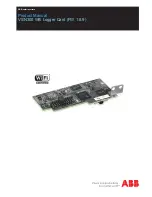
36
•
Operation Theory
4.2
D/A Conversion
There are 2 channels of 12-bit D/A output available in the DAQ/PXI-20XX.
When using D/A converters, users should assign and control the D/A
converter reference sources for the D/A operation mode and D/A channels.
Users could also select the output polarity: unipolar or bipolar.
The reference selection control lets users fully utilize the multiplying
characteristics of the D/A converters. Internal 10V reference and external
reference inputs are available in the DAQ/PXI-20XX. The range of the D/A
output is directly related to the reference. The digital codes that are up-
dated to the D/A converters will multiply with the reference to generate the
analog output. While using internal 10V reference, the full range would
be –10V ~ +9.9951V in the bipolar output mode, and 0V ~ 9.9976V in the
unipolar output mode. While using an external reference, users can reach
different output ranges by connecting different references. For example, if
connecting a DC –5V with the external reference, then the users can get a
full range from –4.9976V to +5V in the bipolar output with inverting
characteristics due to the negative reference voltage. Users could also
have an amplitude modulated (AM) output by feeding a sinusoidal signal
into the reference input. The range of the external reference should be
within ±10V. Table 9 and 10 illustrates the relationship between digital
code and output voltages.
Digital Code
Analog Output
111111111111
Vref * (2047/2048)
100000000001
Vref * (1/2048)
100000000000
0V
011111111111
-Vref * (1/2048)
000000000000
-Vref
Table 9: Bipolar output code table (Vref=10V if internal reference is
selected)
Digital Code
Analog Output
111111111111
Vref * (4095/4096)
100000000000
Vref * (2048/4096)
000000000001
Vref * (1/4096)
000000000000
0V
Table 10: Unipolar output code table (Vref=10V if internal reference is
selected)
















































